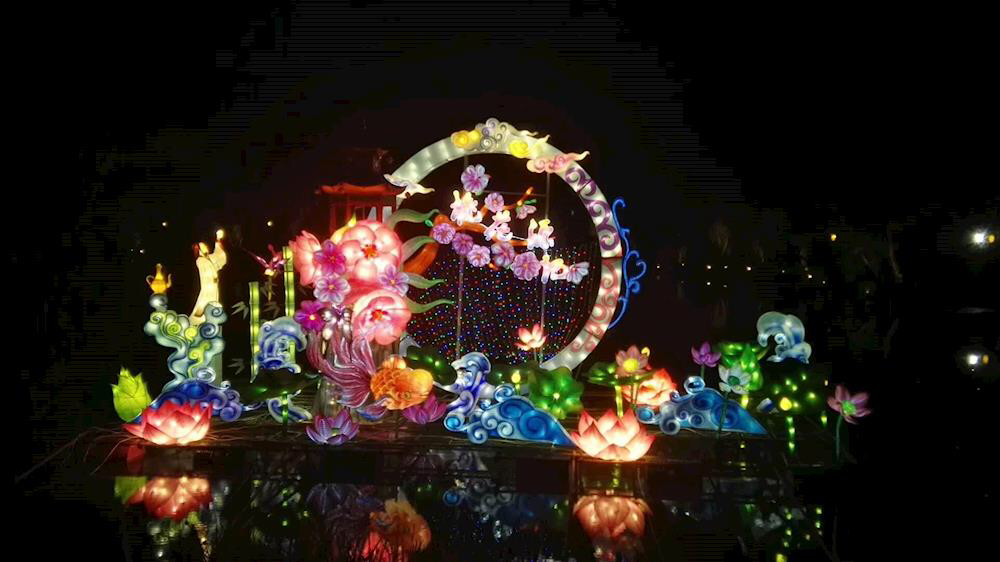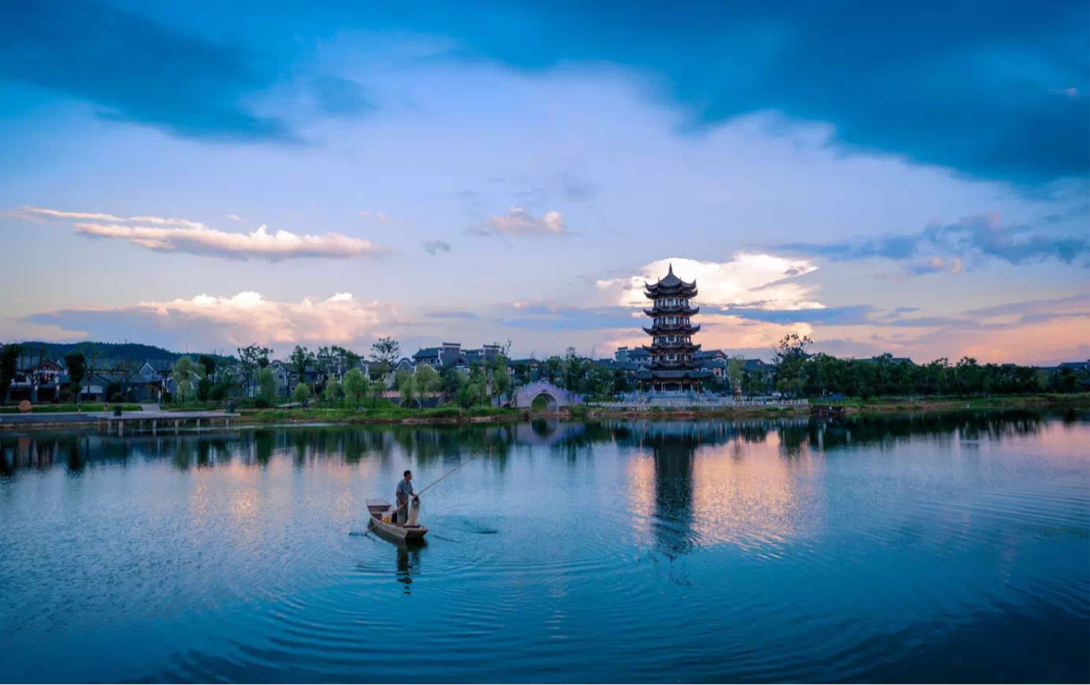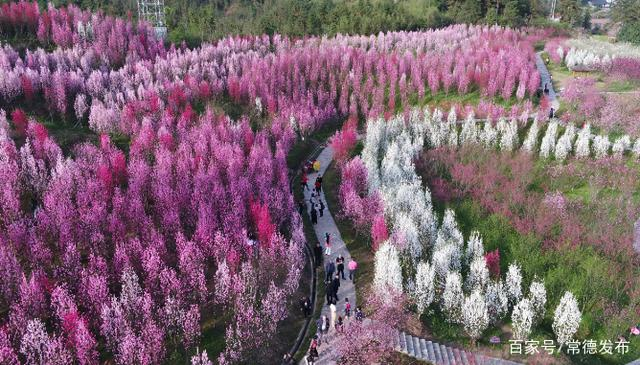Taohuayuan Scenic Area
2022-05-26
It covers a total area of 157.55 square kilometers, including the Xanadu core scenic area of 15.8 square kilometers, the water area of Yuanshui River scenery belt reaching 44.48 square kilometers, and the surrounding protection area up to 96.9 square kilometers. The scenic area has the remains of Daxi Culture in the Neolithic period. It’s also the place referred to by Tao Yuanming in his verse “The Peach Blossom Spring”.

Tao Yuanming is a Chinese poet in the East Jin Dynasty (317-420).
The story describes how a fisherman haphazardly sailed into a stream in a forest made up entirely of blossoming peach trees, where even the ground was covered by peach petals. Then he found an ethereal utopia where the people led an ideal existence in harmony with nature, unaware of the outside world for centuries.
This expresses the author’s longing for a better ideal life and his dissatisfaction with the dark real life at that time. It’s a famous article in the history of Chinese literature. “The Peach Blossom Spring” has become a popular symbol of an ideal world in the hearts of Chinese people.
Taohuayuan was first built in the Jin Dynasty (256-439 A.D), began to take shape in the Tang Dynasty (618-709) and flourished in the Song Dynasty (960-1297). It’s an utopia of both material and spiritual pursuits in China, and has exerted influence on the history and culture of the Chinese nation.

For thousands of years, many literary giants like Tao Yuanming, Li Bai and Su Shi have left countless poems and paintings for it. It’s a cultural holy land where ancient and modern poems, couplets and inscriptions are displayed. There are also many relics of folk culture and ancient buildings.
Taohuayuan ancient architectural complex, which was announced as a key cultural relics unit under state-level protection in 2006, has 15 well-preserved ancient architectural units from the Tang Dynasty to the Republic of China.
At the same time, it also has more than 50 national second-class cultural relics, 107 couplets, 108 inscriptions, more than 1,000 calligraphy and painting works, more than 40 folklores and more than 2,500 poems.
The scenic area has many national intangible protection heritage items and inheritors. Influenced by the cultural celebrities such as Tao Yuanming, Qu Yuan and Liu Yuxi, many precious cultural works relying on the Taohuayuan culture in the past dynasties have created the literary phenomenon and cultural symbol of Taohuayuan.

In 2010, the Hunan Pavilion of Shanghai World Expo was named “Inside Taohuayuan” and made Taohuayuan the image card of Hunan Province to go global. Therefore, Changde is known as the “city in Taohuayuan”. Taohuayuan has been widely recognized in the world.
In 2018, Taohuayuan won many national and provincial honors, including the top ten brands of China’s tourism influential cultural scenic spots, Hunan safe scenic spot, and provincial cross-strait exchange base. And it was shortlisted for the Project Award for China’s Best Natural Ecotourism.
Taohuayuan Scenic Area is composed of four scenic parts: Taohua Hill, Taoyuan Hill, Taoxian Ridge and Qinren Village. Qinren Village is the core of Taohuayuan, which is dotted with more than 70 sights like Taohua Creek, Shuiyuan Pavilion and Yanzhi Hall.
Taoyuan Hill
Taoyuan Hill, also known as Huangwen Hill, is located on the south bank of Yuanjiang River. It is the source of Taohuayuan. It has been the Taoist cultural center of Yuanshui and Lishui River Basins since the East Jin Dynasty. There are three architectural communities in the mountains: Shuifu Pavilion, Taochuan Longevity Palace and Taochuan Academy.

When climbing Taoyuan Hill, you can not only make a pilgrimage to Taochuan Longevity Palace, but also enjoy the “sunset in a fishing village”, one of the eight views of ancient Xiaoxiang (Hunan).
Taohua Hill
Taohua Hill

Taohua Hill is a “Taogong Mountain” that commemorates the artistic conception of Tao Yuanming’s the Peach Blossom Spring, a “national treasure mountain” that gathers 15 national and 1 provincial cultural relics protection units, and a “celebrity mountain” that has left the footprints of many writers and scholars. It can allow visitors to experience what a poem written by Tao Yuanming describes: “while picking asters 'neath the Eastern fence, my gaze upon the Southern mountain rests”.
Wuliu Lake

Wuliu Lake is located between Taohua Hill and Taoyuan Hill. Wuliu is another name of Tao Yuanming.
The scenery is reflected on the water surface of the clear lake—pink peach blossoms and green willows, white walls and black tiles. Taoyuan Industrial Art Exhibition Hall is right in the Wuliu Lake scenic area.
Qinxi River
Qinxi River
Qinxi River, also known as Shuixi River, is one of the important tributaries of Yuanjiang River. According to legend, this is the way by which fisherman mistakenly entered a paradise in the tale of Peach Blossom Spring.

The most beautiful scene is the Qinxi River after rain and in the morning, just like white gauze clothes worn by fairies enveloping the riverside and distant mountains.
Qingu Valley
Qingu Valley
Qingu Valley is about 3.7 kilometers long, adjacent to Qinxi River in the south and Taohua Hill in the north. With simple and quiet pastoral scenery and primitive folk activities here, it perfectly presents the scenes described in Tao Yuanming’s Peach Blossom Spring.

In Tao’s work, the fisherman entered the Qingu valley by the way of Qinxi river. You can feel the warmth and peace of the world in this ancient and natural village.
Peach Forest
Peach Forest

The peach forest is located in Taoxian Ridge in the north of the core scenic area. There are more than 100 peach varieties from around the world. Three ancient peach trees with a diameter of about 2 meters here have witnessed many love legends.


